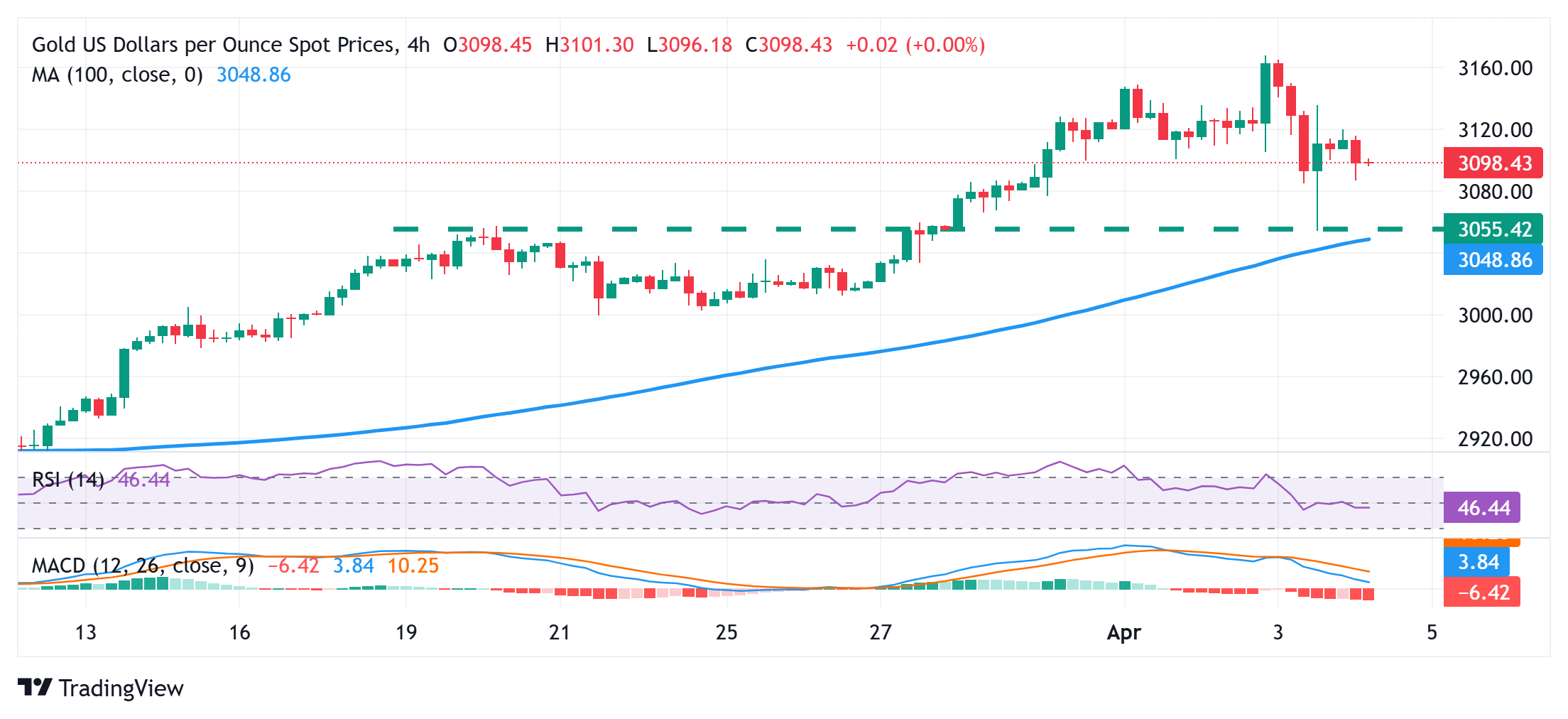Gold price hovers $3,100; bullish bias remains ahead of US NFP report
- Gold price meets with a fresh supply on Friday, though the downside potential seems limited.
- Trump’s tariffs-inspired risk-off mood might continue to act as a tailwind for the precious metal.
- Fed rate cut bets weigh on the USD and should contribute to limiting losses for the XAU/USD pair.
Gold price (XAU/USD) struggles to capitalize on the previous day's late rebound from the $3,054 area, or a one-week low, and attracts fresh sellers during the Asian session on Friday. The commodity slid back below the $3,100 mark in the last hour, though the fundamental backdrop warrants some caution before positioning for any meaningful corrective slide from the all-time peak touched on Thursday.
Concerns that US President Donald Trump's reciprocal tariffs could dent global economic growth and trigger a recession in the US might continue to act as a tailwind for the safe-haven Gold price. Furthermore, the US Dollar (USD) languishes near a multi-month low amid rising bets that the Federal Reserve (Fed) will resume its rate-cutting cycle soon and should help limit losses for the non-yielding yellow metal.
Daily Digest Market Movers: Gold price remains depressed despite a combination of supporting factors
- Gold price attracts some sellers for the second successive day on Friday, though a combination of factors should continue to act as a tailwind and limit any meaningful corrective slide from the record high.
- US President Donald Trump rattled global financial markets late Wednesday and unveiled reciprocal tariffs of at least 10% on all imported goods, which could negatively impact the world economy.
- Traders ramped up expectations that the Federal Reserve will resume its rate-cutting cycle in June and lower borrowing costs four times by the year-end as Trump's trade policies reignite US recession fears.
- The yield in the benchmark 10-year US government bond slides below 4.0% for the first time in six months and fails to assist the US Dollar to build on the overnight bounce from a multi-month trough.
- Meanwhile, data released on Thursday showed that economic activity in the US services sector eased momentum in March, with the ISM Services PMI falling to 50.8 from 53.5 in February and missing estimates.
- Separately, the US Department of Labor (DOL) reported US citizens filing new applications for unemployment insurance ticked lower to 219K for the week ending March 29 from the 225K previous.
- The aforementioned fundamental backdrop favors the XAU/USD bulls. Hence, the modest downtick could be attributed to some repositioning trade ahead of the release of the monthly US employment details.
- The popularly known US Nonfarm Payrolls (NFP) report is expected to show that the US economy added 135K new jobs in March, though the Unemployment Rate is anticipated to hold steady at 4.1%.
Gold price might continue to find support near the overnight swing low, around $3,056-3,054 pivotal support

From a technical perspective, any subsequent fall might continue to find decent support near the $2,056-2,054 horizontal zone. The said area nears the 100-period Simple Moving Average (SMA) on the 4-hour chart and should now act as a key pivotal point for short-term traders. A convincing break below might prompt some technical selling and make the Gold price vulnerable to accelerate the corrective slide further towards the $3,036-3,035 intermediate support en route to the $3,000 psychological mark,
On the flip side, the $3,115-3,125 congestion zone now seems to act as an immediate hurdle. This is followed by resistance near the $3,143 area and the all-time peak, around the $3,157-3,158 region touched on Thursday, which if cleared could be seen as a fresh trigger for bullish traders. This, in turn, will set the stage for an extension of the Gold price's recent well-established uptrend witnessed over the past four months or so.
Gold FAQs
Gold has played a key role in human’s history as it has been widely used as a store of value and medium of exchange. Currently, apart from its shine and usage for jewelry, the precious metal is widely seen as a safe-haven asset, meaning that it is considered a good investment during turbulent times. Gold is also widely seen as a hedge against inflation and against depreciating currencies as it doesn’t rely on any specific issuer or government.
Central banks are the biggest Gold holders. In their aim to support their currencies in turbulent times, central banks tend to diversify their reserves and buy Gold to improve the perceived strength of the economy and the currency. High Gold reserves can be a source of trust for a country’s solvency. Central banks added 1,136 tonnes of Gold worth around $70 billion to their reserves in 2022, according to data from the World Gold Council. This is the highest yearly purchase since records began. Central banks from emerging economies such as China, India and Turkey are quickly increasing their Gold reserves.
Gold has an inverse correlation with the US Dollar and US Treasuries, which are both major reserve and safe-haven assets. When the Dollar depreciates, Gold tends to rise, enabling investors and central banks to diversify their assets in turbulent times. Gold is also inversely correlated with risk assets. A rally in the stock market tends to weaken Gold price, while sell-offs in riskier markets tend to favor the precious metal.
The price can move due to a wide range of factors. Geopolitical instability or fears of a deep recession can quickly make Gold price escalate due to its safe-haven status. As a yield-less asset, Gold tends to rise with lower interest rates, while higher cost of money usually weighs down on the yellow metal. Still, most moves depend on how the US Dollar (USD) behaves as the asset is priced in dollars (XAU/USD). A strong Dollar tends to keep the price of Gold controlled, whereas a weaker Dollar is likely to push Gold prices up.

